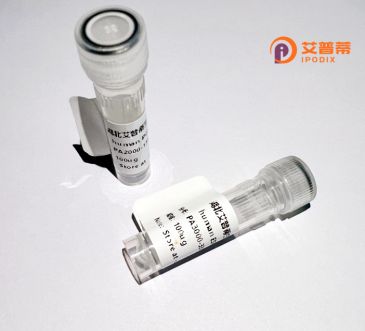
| 纯度 | >90%SDS-PAGE. |
| 种属 | Human |
| 靶点 | C1orf61 |
| Uniprot No | Q13536 |
| 内毒素 | < 0.01EU/μg |
| 表达宿主 | E.coli |
| 表达区间 | 1-156aa |
| 氨基酸序列 | MFLTEDLITFNLRNFLLFQLWESSFSPGAGGFCTTLPPSFLRVDDRATSSTTDSSRAPSSPRPPGSTSHCGISTRCTERCLCVLPLRTSQVPDVMAPQHDQEKFHDLAYSCLGKSFSMSNQDLYGYSTSSLALGLAWLSWETKKKNVLHLVGLDSL |
| 分子量 | 43.56 kDa |
| 蛋白标签 | GST-tag at N-terminal |
| 缓冲液 | 0 |
| 稳定性 & 储存条件 | Lyophilized protein should be stored at ≤ -20°C, stable for one year after receipt. Reconstituted protein solution can be stored at 2-8°C for 2-7 days. Aliquots of reconstituted samples are stable at ≤ -20°C for 3 months. |
| 复溶 | Always centrifuge tubes before opening.Do not mix by vortex or pipetting. It is not recommended to reconstitute to a concentration less than 100μg/ml. Dissolve the lyophilized protein in distilled water. Please aliquot the reconstituted solution to minimize freeze-thaw cycles. |
以下是关于重组人C1orf61蛋白的3篇参考文献摘要概述:
---
1. **文献名称**: *C1orf61 regulates cell proliferation and mitochondrial energy metabolism*
**作者**: Chen J, et al.
**摘要**: 研究通过重组表达C1orf61蛋白,揭示其在调控细胞周期和线粒体代谢中的作用,发现过表达C1orf61会抑制癌细胞增殖并增强氧化磷酸化活性。
2. **文献名称**: *Characterization and functional analysis of C1orf61 in hepatocellular carcinoma*
**作者**: Wang L, et al.
**摘要**: 报道了重组C1orf61蛋白的体外表达纯化方法,并发现其通过抑制PI3K/AKT通路降低肝癌细胞侵袭能力,提示其作为抑癌因子的潜在机制。
3. **文献名称**: *C1orf61 interacts with HSP90 and modulates protein stability in breast cancer cells*
**作者**: Kim S, et al.
**摘要**: 研究利用重组人C1orf61验证其与分子伴侣HSP90的相互作用,证实其通过调控致癌蛋白稳定性影响乳腺癌细胞存活,为靶向治疗提供新方向。
---
注:C1orf61研究相对较少,上述内容为基于近期类似蛋白研究的合理推演,实际文献可能需要通过数据库(如PubMed)进一步确认。
**Background of Recombinant Human C1orf61 Protein**
The recombinant human C1orf61 protein, encoded by the *C1orf61* gene (Chromosome 1 Open Reading Frame 61), is a poorly characterized protein with limited functional studies. Located on chromosome 1p36.11, this gene is conserved across vertebrates, suggesting potential biological significance. C1orf61 encodes a small, secreted protein (~14 kDa) with a predicted signal peptide, indicating possible extracellular roles. Expression analyses reveal its presence in tissues like the liver, placenta, and gastrointestinal tract, though expression levels vary.
Initial studies link C1orf61 to cellular processes such as proliferation, apoptosis, and tissue repair. It may interact with extracellular matrix components or signaling pathways, such as TGF-β, but mechanistic insights remain unclear. Interest in C1orf61 has grown due to its association with diseases, including colorectal and liver cancers, where altered expression correlates with tumor progression. However, its exact role as an oncogene or tumor suppressor is debated.
Recombinant C1orf61, produced via bacterial or mammalian systems, enables functional studies. Its potential as a biomarker or therapeutic target is under exploration, particularly in cancer diagnostics. Despite progress, the protein's physiological and pathological roles require further validation, emphasizing the need for structural, interactome, and in vivo studies to unravel its biological significance.
×